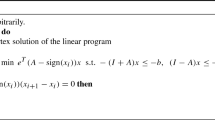Abstract
We investigate equations, inequalities and mathematical programs involving absolute values of variables such as the equation Ax+B|x| = b, where A and B are arbitrary m× n real matrices. We show that this absolute value equation is NP-hard to solve, and that solving it with B = I solves the general linear complementarity problem. We give sufficient optimality conditions and duality results for absolute value programs as well as theorems of the alternative for absolute value inequalities. We also propose concave minimization formulations for absolute value equations that are solved by a finite succession of linear programs. These algorithms terminate at a local minimum that solves the absolute value equation in almost all solvable random problems tried.
Similar content being viewed by others
References
S.-J. Chung and K.G. Murty, “Polynomially bounded ellipsoid algorithms for convex quadratic programming,” In Nonlinear Programming O.L. Mangasarian, R.R. Meyer, and S.M. Robinson (Eds.), Academic Press, New York, 1981, vol. 4, pp. 439–485.
R.W. Cottle and G. Dantzig, “Complementary pivot theory of mathematical programming,” Linear Algebra and its Applications, vol. 1, pp. 103–125, 1968.
R.W. Cottle, J.-S. Pang, and R.E. Stone, The Linear Complementarity Problem, Academic Press, New York, 1992.
CPLEX Optimization Inc., Incline Village, Nevada. Using the CPLEX(TM) Linear Optimizer and CPLEX(TM) Mixed Integer Optimizer (Version 2.0), 1992.
O.L. Mangasarian, Nonlinear Programming, Reprint: SIAM Classic in Applied Mathematics 10, 1994, Philadelphia, McGraw–Hill, New York, 1969.
O.L. Mangasarian, “The linear complementarity problem as a separable bilinear program,” J. Global Optim., vol. 6, pp. 153–161, 1995.
O.L. Mangasarian, “Solution of general linear complementarity problems via nondifferentiable concave minimization,” Acta Mathematica Vietnamica, vol. 22, no. 1, pp. 199–205, 1997, ftp://ftp.cs.wisc.edu/math-prog/tech-reports/96-10.ps.
O.L. Mangasarian and R.R. Meyer, “Nonlinear perturbation of linear programs,” SIAM Journal on Control and Optimization, vol. 17, no. 6, pp. 745–752, 1979.
MATLAB. User’s Guide. The MathWorks, Inc., Natick, MA 01760, 1994–2001. http://www.mathworks.com.
R.T. Rockafellar, Convex Analysis Princeton University Press, Princeton, New Jersey, 1970.
J. Rohn, “Systems of linear interval equations,” Linear Algebra and Its Applications, vol. 126, pp. 39–78, 1989. http://www.cs.cas.cz/~rohn/publist/47.doc.
J. Rohn, “A theorem of the alternatives for the equation A x+B|x| = b,” Linear and Multilinear Algebra, vol. 52, no. 6, pp. 421–426, 2004. http://www.cs.cas.cz/~rohn/publist/alternatives.pdf.
Author information
Authors and Affiliations
Corresponding author
Rights and permissions
About this article
Cite this article
Mangasarian, O.L. Absolute value programming. Comput Optim Applic 36, 43–53 (2007). https://doi.org/10.1007/s10589-006-0395-5
Received:
Revised:
Published:
Issue Date:
DOI: https://doi.org/10.1007/s10589-006-0395-5



